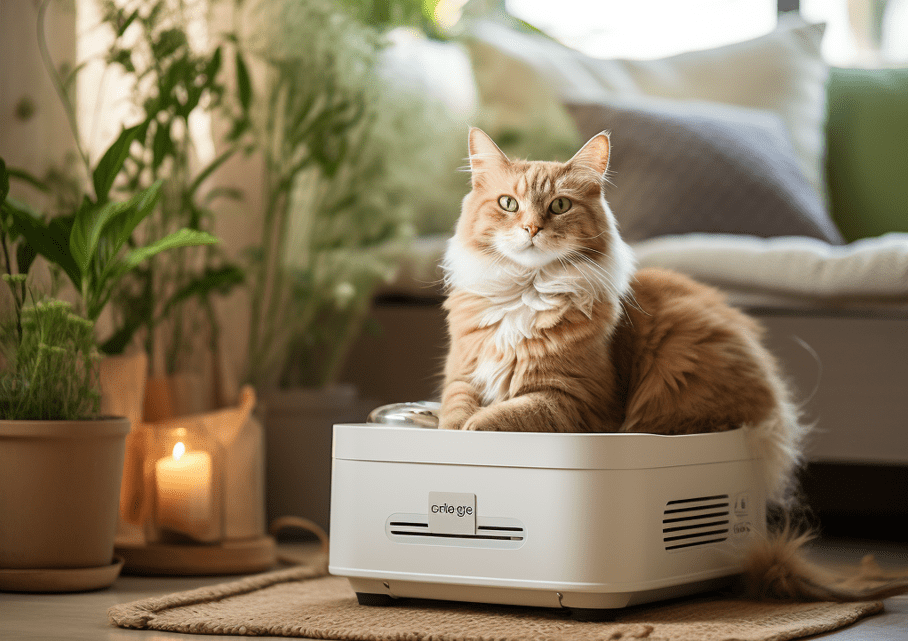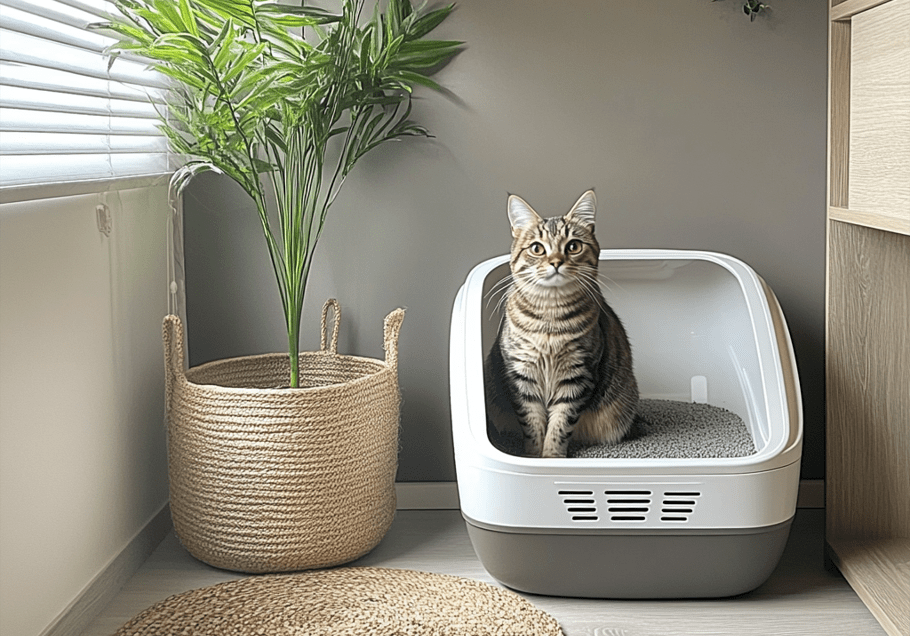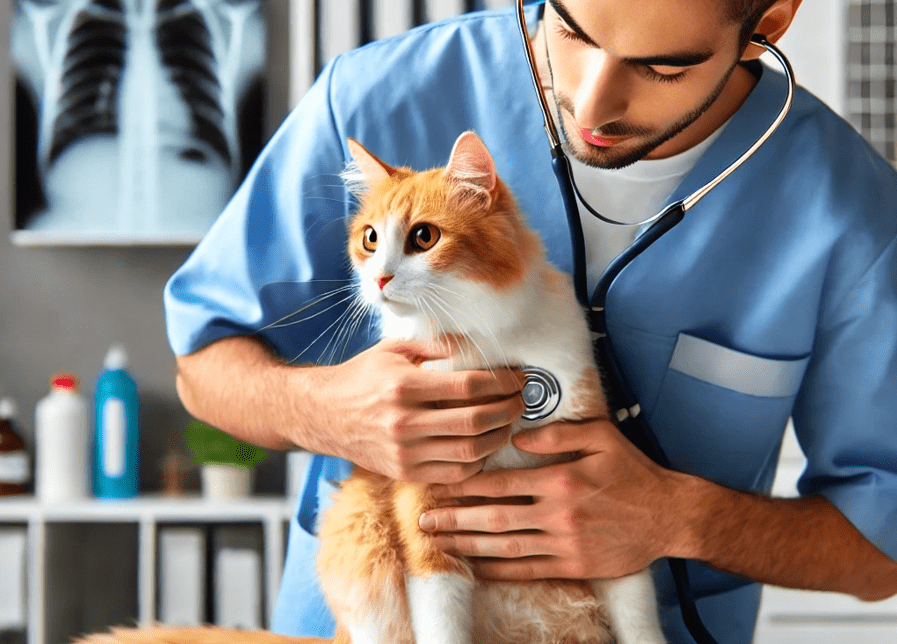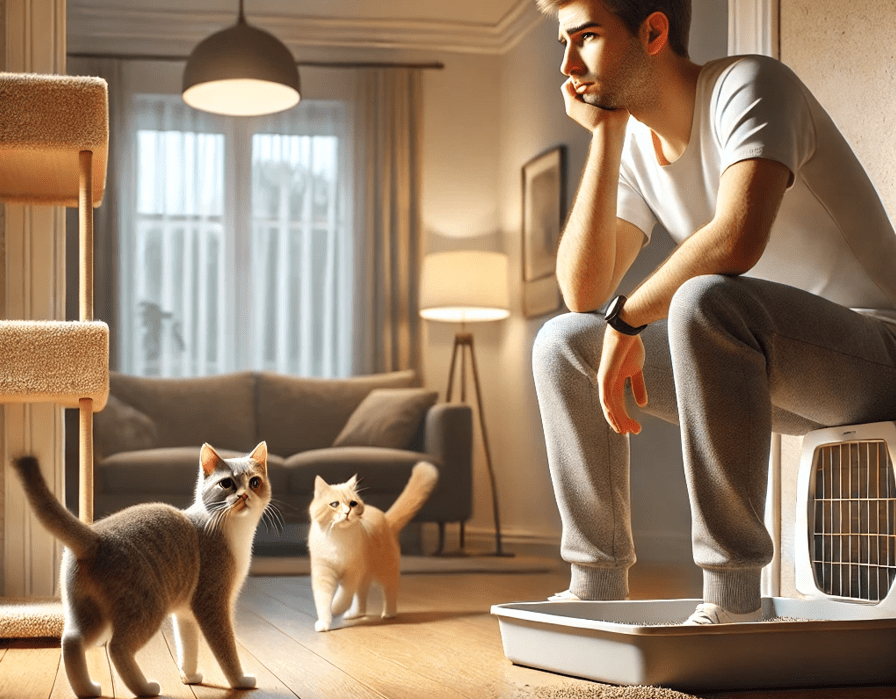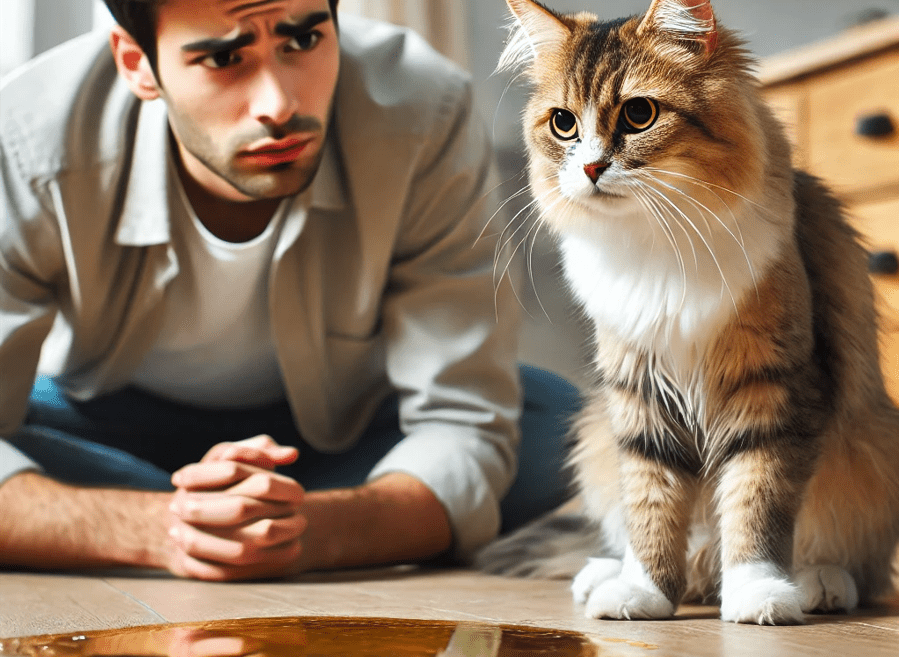
When dealing with a cat urinating outside the litter box, it’s common to find urine in various parts of your home. Cats display two distinct patterns of inappropriate urination: random scattering of their urine throughout your house and selective spots, such as bathtubs and beds. You need to understand the reason for inappropriate urination before deciding on a solution for your cat. A cat may choose to urinate outside its designated litter area because of physical or psychological health problems. In this article, we will tell you several medical and behavioral reasons for a cat urinating outside the litter box and provide guidance on how to address these issues effectively.
1.Medical Reasons for Cat Urination Outside the Litter Box
The initial step for correcting inappropriate urination in cats requires a veterinary check-up. During the checkup, the veterinarian will conduct a physical assessment together with urine testing. The treatment recommendations will come from the examination results your veterinarian conducts. Inappropriate urination emerges from various medical problems that affect feline bodies. Some of the more common include:
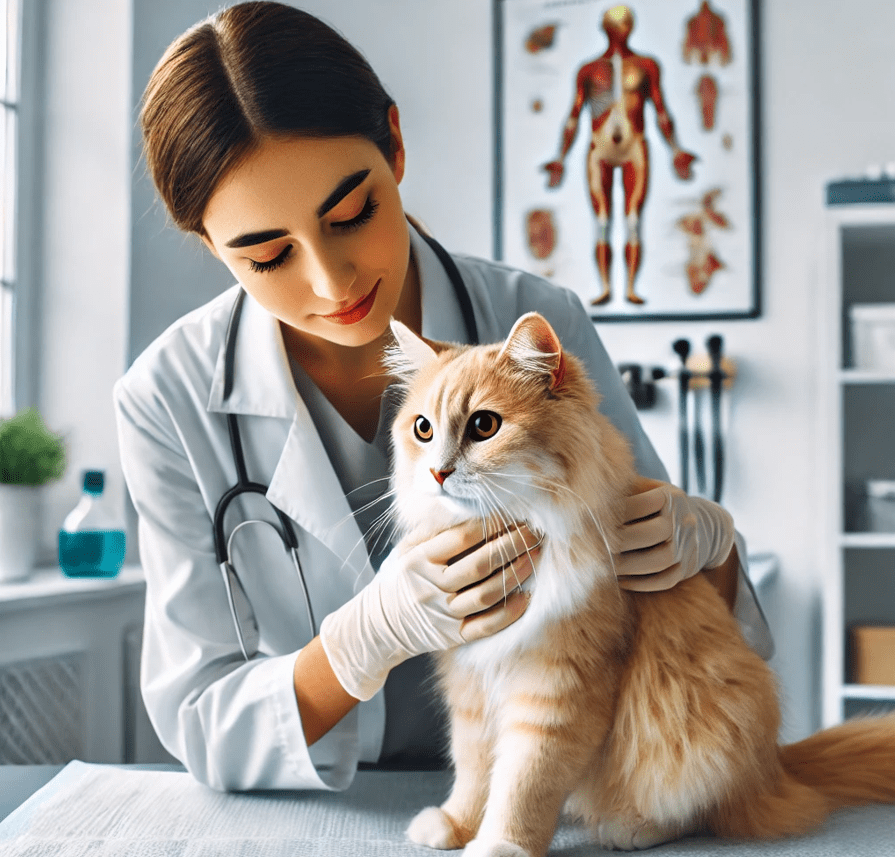
1.1 Urinary Tract Infection
Young cats avoid getting urinary tract infections, although these infections frequently result in urinary problems for older cats. The urinary tract will experience inflammation when bacteria in the urine enter the system. Treatment of urinary tract infection requires antibiotic medication. Your vet will need to conduct regular infection tests to confirm that the infection has cleared up after the antibiotic treatment.
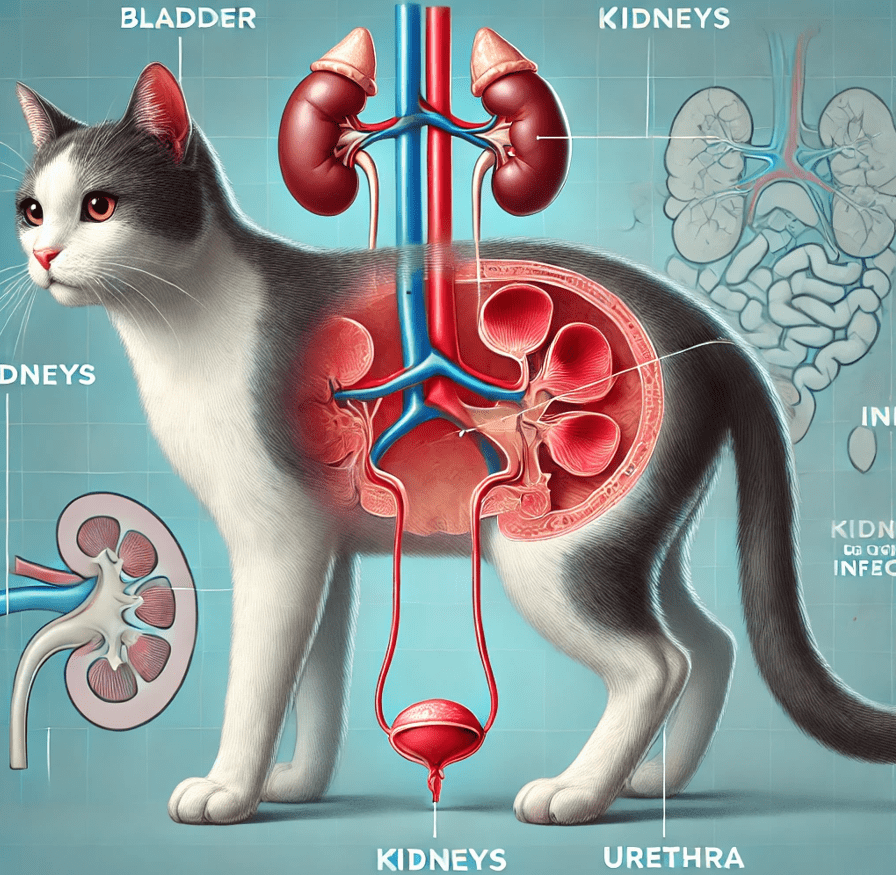
1.2 Bladder Stones
Some cats form bladder stones, which result in irritation as well as the possibility of creating a blockage. Crystals in the bladder can detect both bladder stones and their formation precedents. The presence of bladder stones requires X-ray imaging to check stone dimensions and amount according to the vet’s assessment. Proper dietary treatment could dissolve smaller stones within the bladder, but veterinary surgery (cystotomy) is necessary to remove larger stones. The majority of cats who develop bladder stones will also suffer from UTI. In this case, we will need to administer antibiotics.
1.3 Idiopathic Cystitis
Both the words cystitis and inflammation of the bladder convey the same meaning. Science does not recognize the origin of this condition. Cats who suffer from cystitis most commonly develop urine that contains blood (hematuria). Microscopic examination is needed to detect blood in urine samples because blood presence might remain invisible unless urine is tested. When your veterinarian finds blood in the urine with no crystals or bacterial presence or stone formation, your cat most likely has idiopathic cystitis. Medical professionals handle this condition through dietary modification combined with environmental enhancement strategies. Doctors can prescribe both pain-relieving and anxiety-fighting medications as treatments.
1.4 FLUTD
A chronic condition affecting one or more urinary tract issues receives the medical diagnosis of feline lower urinary tract disease, or FLUTD. Your veterinarian will suggest a urinary diet together with supplements for the urinary tract if your cat receives an FLUTD diagnosis.
A urinary obstruction presents a serious danger to male cats, especially when the condition occurs. Your cat may have a blockage or partial obstruction in its urinary tract if it postures to urinate but produces very little urine. Please promptly bring your cat to a veterinarian, as the condition can quickly become a serious threat to its survival.
1.5 Systemic Disease
Cats exhibit inappropriate urination behavior because they suffer from another health issue that is not urinary in nature. Your kitties may pee outside due to discomfort stemming from another part of their body.
The presence of chronic kidney disease manifests through increased urination amounts. Liver disease and diabetes, along with thyroid disorders, cause cats to increase their urination. Take your cat to see a veterinarian when you notice your cat drinking extra amounts, urinating excessively or when you need to clean the litter box more frequently.
Lab work becomes necessary for your veterinarian to identify potential health problems after conducting an initial examination with urinalysis. Medical examinations performed in a laboratory reveal severe health problems; therefore, early diagnosis enables veterinarians to start prompt treatment.
2.Behavioral Reasons for Cat Urination Outside the Litter Box
Owners find inappropriate urination one of the most aggravating issues in pets, and it leads to most cats being surrendered. After eliminating medical causes of inappropriate urination under your veterinarian’s assessment, you should identify environmental factors that cause your cat’s unwanted behavior. Behavioral inappropriate elimination can be transformed through owner dedication, which lets both you and your cat enjoy a superior quality of life. Behavioral causes can present as the root explanation for your cat’s inappropriate urination behavior if there are no detected medical reasons. Evaluating your cat’s surroundings should be your first move toward diagnosing possible environmental causes of behavioral changes.
2.1 Litter Box Preferences
Cats display particular preferences regarding which litter box they will use. Cats exhibit various choice preferences, such as how close the box should be to home activities and their tolerance towards noise despite it being located adjacent to the washing machine, along with preferences regarding whether their box should be covered by a lid or uncovered and preferences in the type of litter with its smell and texture sensations. Finding solutions to cat litter box problems requires testers to identify what specific preferences the cat will accept.
2.2 Dirty Litter Box
An unclean litter box is the main cause of inappropriate urination. Cats select clean environments for both toileting and resting. You should empty the litter box daily for proper maintenance, change the litter as necessary, and clean the box completely every one to two weeks.
2.3 Old Urine Smells
Urine residues from previous sailings will make cats return to spots because of their scent detection abilities. The remnant smells from cleaning an accident may prompt the cat to repeat the behavior at the site. The urine detector shows where stains exist before you apply a stain and odor remover to thoroughly clean up the area.
2.4 Stress
Stress strongly influences inappropriate urination behavior. Various types of stressors that may lead to inappropriate urination include the presence of another animal in the home; house moves; and having new people live in the residence. Cats respond sharply to any slight change that occurs within their environment. You should maintain a calm atmosphere throughout your cat’s territory while providing them with a private space that serves as their sanctuary.
3.How to Stop a Cat from Peeing Outside the Litter Box
After understanding the causes, you can stop your cat from peeing outside the litter box.
3.1 Rule Out Medical Concerns
You must first check with your veterinarian before addressing behavioral problems on your own. A veterinarian must evaluate medical explanations even though extra symptoms are absent. The treatment of medical conditions resolves any root problems while the veterinarian provides suggestions about behavioral matters.
Scheduling regular veterinary appointments along with a quick response to cat health issues helps prevent the development of new behavioral problems.
3.2 Improve Litter Box Conditions
Among all the reasons that cause cats to misuse the bathroom, the litter box stands out as a leading offender. After eliminating medical conditions, you should optimize your litter box arrangement.
Cats usually prefer roomy litter boxes that remain open so large and fluffy pet animals find these spaces more inviting.
Select a suitable spot for the litter boxes, which should be located in peaceful zones that are easily accessible and separate from food supplies. The use of a decorative screen solves privacy issues when you place the litter box.
3.3 Reduce Stress
The high levels of stress within a home environment lead to urinary problems, but proper home care can decrease these symptoms. Recommendations include:
Supplements alongside pheromones are worth trying if changes to the environment do not improve the situation. Treatment with medication to decrease anxiety can be prescribed to patients when their condition becomes severe, according to the veterinary professional.
3.4 Seek Professional Help
If the problem persists, consult your vet about finding a certified behaviorist. Patience and consistency are key to resolving these challenges.
3.5 Aversion and Attraction Therapies
Addressing outside litter box habits in your cat needs urgent medical attention. A quick solution to the problem will succeed when the inappropriate behavior is recent and your cat selects only one or two locations indoors for elimination. As time passes, there is an increased likelihood the initial conditions will no longer apply to the inappropriate behavior.
Start by talking to your vet. The physician must provide guidance concerning two active therapeutic options, including litterbox attitude modification and the use of minimal drug treatment.
A behavior modification strategy for kitties must combine two methods that use aversion therapy alongside attraction therapy.
Aversion therapy:
The treatment methods work to establish inappropriate elimination as something your cat will actively avoid. Treatment for inappropriate elimination occurs through multiple approaches, including:
When cleaning areas where your cat urinates, your goal should be to use odor-neutralizing products. The odor masking solutions available in the market do not function as deterrents for cats, thus allowing them to revisit previously soiled areas.
Place secured double-sided tape or aluminum foil across the affected areas to protect the furniture or carpet. Most cats prefer to avoid walking on these types of textures.
Use orange or lemon peels as floor markers at the base of your potted plants where your cat currently uses as a bathroom area. You can use plastic or cardboard sheets to prevent your cat from digging and gaining access to potting soil.
Attraction therapy:
People can successfully show their feline companion that their choice for urination should be the litter box despite it being harder to accomplish. The following strategy provides steps to help this process:
Select enough boxes to cover your number of cats together with an extra one. A minimum of three boxes should be used for the two cats you have.
Purchase unscented clumping litter. The scents of most conventional cleaning products repulse cats, and clumping litter appears more attractive to cats than regular clay litter.
You should position a new litter box near the inappropriate urination spot to help your kitty start using it. You should progressively move the litter box from its original place to two or three feet away each day until it reaches its designed spot. How long it takes for the litterbox to reach its starting spot and your daily displacement distance depends completely on your cat’s improvement rate.
The original litter box should remain at its regular spot to provide an alternative if your cat uses aversion therapy to recover its former habit of using the box.

